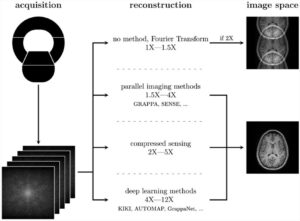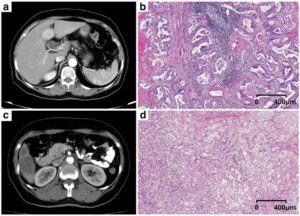We recently spoke with Jörg Aumüller, who leads the Digital Health global marketing team at Siemens Healthineers. In our interview, we touched on the issue of growing medical data, how companies can stay ahead of legal and regulatory challenges, new roles and professions being created as a result of the introduction of AI tools and technology, and how these tools will affect radiology and healthcare in the near future.
How will AI tools and technology assist radiologists in order to account for the exponential growth in medical data, e.g. the increase of CT and MRI examinations and low increase of radiologists?
One of the segments that has opened up in the AI medical industry is radiology. Fast adoption of AI is to be expected; on the one hand, due to the technical maturity level of radiology, and on the other hand due to the socio-economic predicament caused by rising staff shortages and the ageing of most global populations. There is a growing gap that has become more easily recognizable in recent years – the gap between the numbers of scans being done and the number of radiologists available to read them. There were, and still are, simply not enough radiologists being certified each year to cover the rising number of scans. That also creates quite a logical problem. Higher workloads place pressure on the interpretation time, and that causes the error rate to increase. To be more exact, according to a 2015 study in the Journal of the American College of Radiology, a 50% drop in interpretation time came with a 16.6% increase in the error rate. To solve this problem, AI capabilities need to be utilized to quickly analyze large volumes of image data to create meaningful, yet actionable, insights.
Because so much data is needed to train algorithms, how can companies stay ahead of legal, ethical, and regulatory issues associated with collecting and using data?
AI can be a transformative technology that can generate meaningful benefits for individuals, but clear guidance for its implementation in healthcare is still recommended. There are compaines who are active contributors in various committees and associations that are created to help develop guidelines and regulatory frameworks with regard to a trustworthy AI. Also, many companies are in close contact with local authorities when it comes to the development and release of AI-powered solutions. Moreover, it should be an inherent part of medical technology companies to act in compliance with the legal, ethical, and data privacy requirements, especially when developing their solutions. Privacy by design and by default should be the key principles driving developments, as well as closely monitoring and contributing to the considerations in the industry with respect to ethics by design. These high standards are of the utmost importance when developing AI-powered solutions.
How much more ubiquitous will ‘deep machine learning’ become as technology develops, as opposed to the increase of standard ‘machine learning’?
I think deep machine learning will become more and more ubiquitous as time goes on. With that said, traditional machine learning will still have its place in technology, because some tasks will just not require the complexity of deep learning. Also, with simpler tasks, traditional machine learning would even be preferable considering it would be able to handle the task quicker and with less energy and time spent on processing. But, when the task is more complex and data sets are large and multivariant, then deep learning is definitely the correct choice. This is because deep learning uses multi-layer neural networks with multiple hidden layers between the input and output layers ultimately aiming for higher accuracy. Therein also lies a challenge, having large enough curated datasets to train a deep learning-based model. So, both deep and traditional machine learning approaches will have their own fields going forward.
What gaps in medical imaging have yet to be filled by AI?
In medical imaging, there are mountains of data that need to be handled, processed, and interpreted. AI has the potential to accomplish these tasks by helping to reduce workload or even helping to improve and standardize processes. This can be beneficial for support when it comes to physically operating the imaging devices; for example, assisting with positioning, protocols, and control parameters. Also, it can create more automated processing to help detect and quantify defined anatomies and abnormalities in imaging data. Allowing for support of diagnostic guidance with regards to multimodality views or image fusion support for data analytics and finding patterns, not limited only to imaging but also with other medical data.
What types of professional roles will we see evolve alongside the development and increasing use of AI tools and technology in radiology and healthcare?
I think we are going to see some professions springing up in the medical field that technically belong in a place like Silicon Valley – for instance, a data scientist. This is because the line between something like a medical image and a statistical parameter is becoming blurred. As AI becomes ever more useful for radiology, the AI savvy radiologist will be the radiologist in demand. This demand will also facilitate the creations of new professions, like a “radiological data scientist” with additional skills in analytics and data science, or “patient flow managers” that help patients and clinicians to have more frictionless interactions with guidance through clinical pathways that are supported by digital health tools.
As a follow-up, how will these new professional roles affect the daily workflow?
The whole purpose will be to remove outside distractions away from the radiologists and let them concentrate on more specific value-adding tasks and letting them focus on their expertise. Radiological data scientists may do so by utilizing algorithms that could help in the radiology department to reduce tedious tasks during image scanning, data processing, and interpretation. Patient flow managers will look to help guide patients through clinical pathways more effectively by being able to access their relevant data in a structured and simple way.
Where do you see the largest application of AI tools in the next 5-10 years within radiology/healthcare?
An exciting field for AI-powered support applications is the interpretation of medical images along multiple body regions. Another very promising field of application is the use of AI to generate predictions based on multiple data sources from diverse points in time. This would be of help, for example, for treatment decisions of cancer patients, or therapy adherence of chronic diseases in particular; and, it has the potential to incorporate cohort-centric insights as well.
In which radiological or healthcare areas do you see the impact of AI tools in developing countries and why?
Sticking with radiology, I think the issues and impacts are very similar, just more pronounced. Let’s take the example of the Democratic Republic of the Congo; for every 1,000 people, they have 0.11 doctors, while Germany has 3.4. If a radiologist becomes overwhelmed in Germany, then it becomes hard to imagine what a Congolese radiologist has to deal with. Helping to enhance their workflows with AI would be a game-changer, and getting these technologies out to developing countries is very relevant for the healthcare industry, thus improving access to healthcare.
 Jörg Aumüller leads the Digital Health global marketing team at Siemens Healthineers headquarters in Erlangen, Germany. In his role, he collaborates with healthcare providers, digital thought leaders, regulatory bodies, and Medtech stakeholders to help bring healthcare information technology to bear in solving clinical challenges. Prior to his current role, he held a variety of positions at Siemens Healthineers and consulting companies related to Artificial Intelligence and Healthcare IT product management. He earned his diploma in business administration with the focus on business informatics.
Jörg Aumüller leads the Digital Health global marketing team at Siemens Healthineers headquarters in Erlangen, Germany. In his role, he collaborates with healthcare providers, digital thought leaders, regulatory bodies, and Medtech stakeholders to help bring healthcare information technology to bear in solving clinical challenges. Prior to his current role, he held a variety of positions at Siemens Healthineers and consulting companies related to Artificial Intelligence and Healthcare IT product management. He earned his diploma in business administration with the focus on business informatics.













